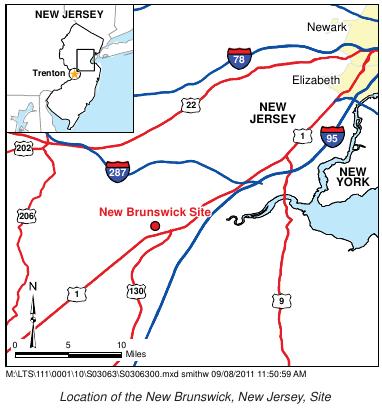The EEOICPA was passed in 2000. It provides compensation to workers who became ill as a result of their employment manufacturing nuclear weapons in the USA, as well as their spouses, children, and grandchildren. New Brunswick Laboratory EEOICPA coverage is available for qualified former Workers and their families.
Are you eligible for compensation? If you or a family member worked at this or another DOE facility and became ill, you may be entitled to compensation of up to $400K plus medical benefits. Call EEOICPA Counsel Hugh Stephens at 1-855-548-4494 or fill out our free claim evaluation, We can help even if you’ve already filed, even if your claim was denied!
Here, we have compiled publicly available information and documentation about the facilities covered by the Act to clarify how their activities relate to the Energy Employees Occupational Illness Compensation Program Act.
New Brunswick Laboratory
State: New Jersey
Location: New Brunswick
Time Period: 1948-1977
Facility Type: Department of Energy
Facility Description: From 1948 to 1978, the Atomic Energy Commission (AEC), a predecessor agency of the Department of Energy (DOE), used the New Brunswick Laboratory as a general nuclear standards laboratory for assaying nuclear and non-nuclear materials used in reactor and weapons programs. The New Brunswick Laboratory (NBL) provided a variety of activities using nuclear materials, including thorium and uranium ores, high purity plutonium and americium, and enriched uranium.
In 1977 the New Brunswick Laboratory was moved from New Jersey onto the campus of Argonne National Laboratory — East, where it remains today.
Throughout the course of its operations, the potential for beryllium exposure existed at this site, due to beryllium use, residual contamination, and decontamination activities.
Listing:
New Brunswick Laboratory is listed as a Department of Energy (DOE) site under the EEOICPA.
Compensation:
As of 04/26/2015, the total compensation paid under Parts B and E of the EEOICPA, including medical compensation, for workers suffering from the effects of having worked at the New Brunswick Laboratory is $323,047.
New Brunswick Laboratory Workers:
If you or your parent worked at this or any other DOE or AWE facility and became ill, you may be entitled to compensation of up to $400K plus medical benefits from the US Department of Labor. Call EEOICPA Counsel Hugh Stephens at 1-855-EEOICPA (336-4272) or fill out the form to the right, whether ot not you have already filed a claim and even if your claim has been accepted or denied.
We can help with all OWCP (Federal Workers Compensation) claims, impairments, wage loss and health care. 2495 Main Street, Suite 442 Buffalo, NY.
*Site Description and History:
The New Brunswick, New Jersey, Site (site of the former New Brunswick Laboratory) is located in an industrial area at 986 Jersey Avenue, approximately 1.6 miles from down- town New Brunswick. The 5.6-acre site consists of a vacant and fenced grass-covered lot, and is bordered by Jersey Avenue on the west, a main rail line and vacant property on the east, and industrial property on the north and south.
The U.S. government used the laboratory for nuclear reactor and weapons programs from 1948 to 1977. The site included a main laboratory building, a plutonium laboratory complex, and nine other support buildings. Thorium and uranium ores, plutonium, americium, and enriched uranium were all used at the laboratory. In 1960, soil containing pitchblende (an ore containing uranium) residue was shipped from the Middlesex Municipal Landfi ll to the New Brunswick site, where it was mixed with clean soil in order to fi ll an abandoned rail spur that entered the eastern side of the property. The facility was closed in 1977, and laboratory operations were relocated to Argonne National Laboratory. The 29 years of operations at the site resulted in radiological contamination of the property.
The U.S. Department of Energy (DOE) remediated most of the site in two phases. Phase I, completed in 1978, included removing plumbing and equipment and portions of floors, walls, and ceilings. Phase II, conducted from 1981 through 1983, removed all aboveground structures, including contaminated concrete foundations, drain lines, and soil. Phase II waste and debris were shipped to the Nevada Test Site for disposal and 13 groundwater monitoring wells were installed.
After the two remediation phases were completed, verification surveys and sampling showed that the filled railroad spur and a spot midway along the southern fence line were contaminated with uranium, radium, and thorium. The additional remediation was assigned to the Formerly Utilized Sites Remedial Action Program (FUSRAP).
Contaminated soil was removed with heavy equipment, soils were separated using a segmented gate system, and shipped by rail to a licensed disposal facility.


















